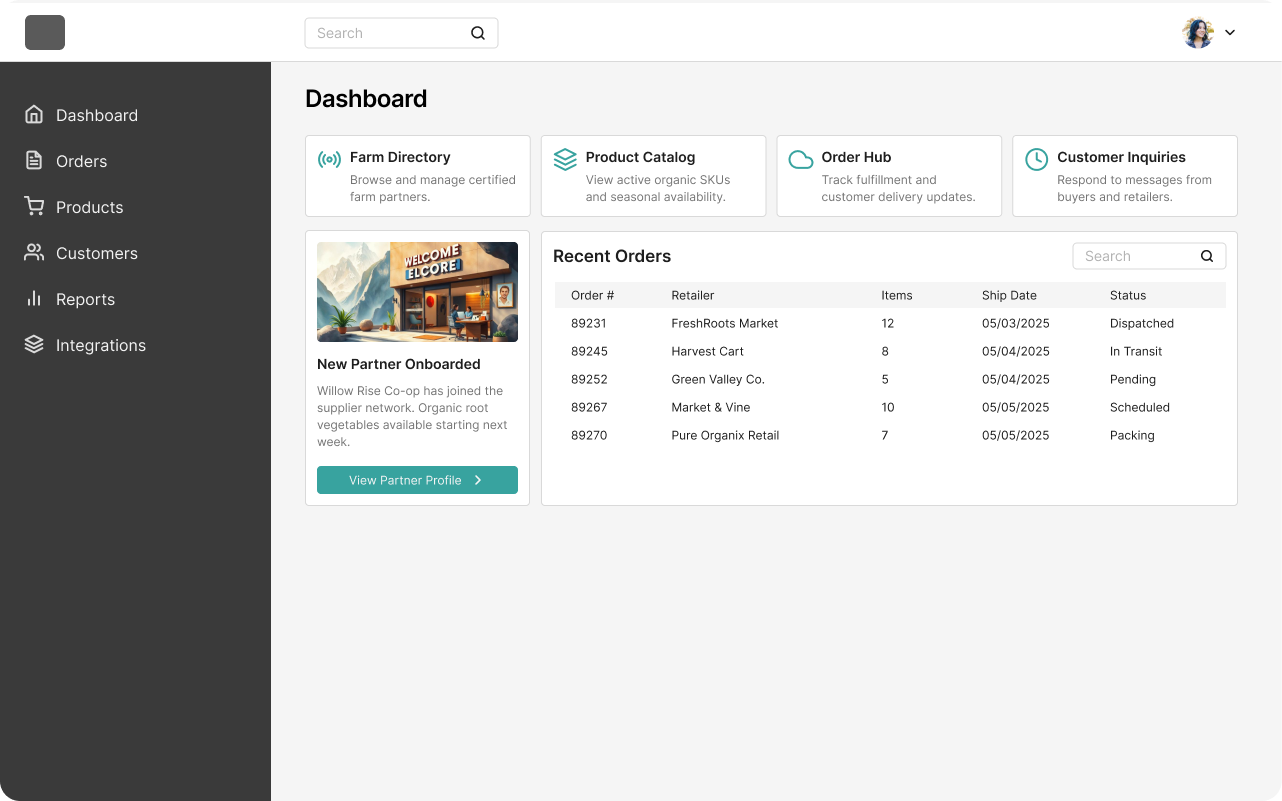Portfolio • Web Design & Development • 10-30-25
B2B Portal Prototype
I developed a modular B2B dashboard prototype focusing on clean UX and efficient front-end architecture, organizing complex business functions into intuitive, interactive components.

Project Overview
This project involved designing and building a modular B2B dashboard prototype, serving as a hands on exploration into creating intuitive user experiences for complex business applications. My primary aim was to demonstrate how efficient frontend architecture could support a highly organized interface, making core business functions like onboarding, managing product catalogs, tracking orders, and handling customer inquiries easily accessible and manageable through interactive components.
The dashboard was specifically designed to provide a centralized and streamlined view for businesses operating within the Agriculture & Supply Chain industry. This required a deep understanding of presenting diverse data sets and operational tools in a cohesive, user friendly manner, aiming to enhance daily workflow efficiency.
Challenges
Developing this dashboard presented unique challenges, particularly in creating a truly modular and scalable architecture that could seamlessly integrate diverse business functions. The goal was to ensure each component, from onboarding flows to complex product catalogs, operated independently yet contributed to a unified user experience. This required careful planning to prevent feature creep and maintain a clean, high performance interface, especially given the potential for extensive data within a B2B context.
Another significant hurdle was designing a clear and intuitive navigation system for users dealing with varied responsibilities (e.g., procurement, sales, customer service). Balancing comprehensive functionality with a simple, uncluttered UX was paramount to making sure the dashboard was genuinely useful rather than overwhelming.
Process
My process began with in-depth UX design in Figma, where I meticulously mapped out user flows for each business function. I created wireframes and high fidelity mockups, paying close attention to information hierarchy and component states. The "modular" aspect heavily influenced this phase, as I designed atomic components that could be reused and reorganized flexibly.
Moving into development, I built the dashboard using a component based approach with HTML5 and SCSS for structure and styling. Vanilla JavaScript was the engine for all interactivity, handling everything from component rendering and state management to dynamic content loading. I focused on creating a robust, maintainable codebase, ensuring that each module could function independently while integrating smoothly into the larger system. This iterative process allowed for continuous refinement of both design and functionality, ensuring the prototype met its goals for clarity and efficiency.
Tech Decisions
The decision to use a pure HTML5, SCSS, and JavaScript stack was deliberate, driven by the desire to build a lightweight, high performance prototype with maximum control over the underlying code. This approach allowed for a deep dive into efficient frontend architecture patterns, focusing on modularity and reusability without the overhead of external frameworks. Each component was self contained, promoting easier maintenance and future scalability.
SCSS was pivotal for creating a flexible and thematic styling system, enabling quick design adjustments while maintaining consistency across the dashboard. Vanilla JavaScript was critical for implementing dynamic interactions, data manipulation, and efficient content rendering, proving that complex UIs could be effectively managed with foundational web technologies. This project served as a testament to building robust applications with a strong emphasis on core web capabilities.
Key Takeaways
This project fundamentally deepened my understanding of how core web technologies (HTML5, SCSS, and ES6 JavaScript) can be meticulously leveraged to build sophisticated, highly modular applications, even for complex B2B scenarios. It demonstrated that achieving efficient, maintainable, and scalable frontend architecture doesn't always necessitate heavy frameworks; disciplined use of fundamentals can yield exceptional results.
I gained valuable insights into organizing diverse business functions within a unified interface, emphasizing the power of component-based thinking in plain JavaScript to manage complexity and promote reusability. This experience refined my ability to translate intricate operational requirements into clean, user centric designs that directly enhance workflow efficiency and clarity for business users. It solidified my conviction in designing for long-term adaptability within enterprise level applications
Quick Details
- Year 2024
- Industry Agriculture & Supply Chain
- Role UX Engineer
- Category Web Design & Development
- Platform CodePen
- Duration --
Technologies Used
Color Palette
Each color was selected to support accessibility, visual hierarchy, and a clean, modern interface.